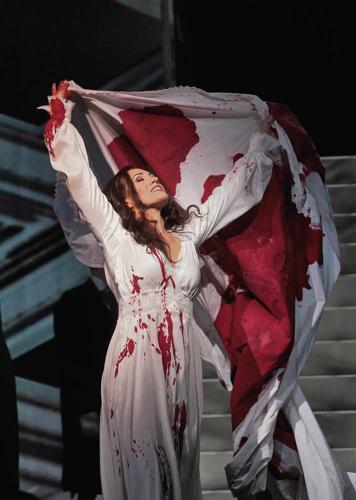Santa Fe Opera’s opening weekend continued on Saturday with a thoughtful, engrossing new production of Donizetti’s Lucia di Lammermoor directed by Ron Daniels. At the head of the cast is soprano Brenda Rae. She displayed fine musical sensitivities, fluent technique and dramatic flair in her depiction of the hapless heroine forced by her brother to abandon the man she loves and marry the groom he has chosen — and sheds her sanity in the process.
The set design, by Riccardo Hernandez, is minimal and abstracted — walls patterned like a paneled ceiling with occasional projected overlays of vegetation or landscape, an Act 1 fountain that resembles a modernist fish tank, a bed and a few chairs as needed, a staircase that emerges in Act 3. The visual interest is concentrated instead on the costumes. Emily Rebholz designed them in a historical style I would guess to be from the 1840s, the period when this opera was staking its indelible place in the repertoire. They are most stunning in the wedding scene — women in subtly shimmering taffeta gowns of muted tones (plum, moss, light eggplant), the groom and his gentleman friends arrayed in gorgeous black coats richly embellished in gold. This Lucia goes easy on the plaids, although a few figure in the outdoor garb of the fellows who patrol the chilly Scottish terrain. Christopher Akerlind’s lighting highlights everything effectively and heightens the drama in the scene by the fountain; there, a high-contrast beam seemingly emanates from the fountain to illuminate Lucia’s face as she recalls the portentous tale of a lover’s murder that took place on that spot.
But when all is said and done, bel canto opera — and certainly Lucia di Lammermoor — is about singing rather than stage accoutrements, and performing such a work would be pointless without strong talents in the principal roles. Rae is on stage a lot and works hard, but she doesn’t show it. Already in her opening scene, particularly in her cabaletta “Quando rapito in estasi,” her coloratura displayed a relaxed technical mastery that allowed her to bend the tempo without breaking it. The result was fluid while respecting the stylistic intentions of bel canto expression. In her Act 2 “Il pallor funesto” (which expands into a duet with her brother), she unleashed textbook renditions of high-velocity scales ascending and descending, diatonic and chromatic, all finely calibrated; and then she brought definition to the dotted rhythms in her ensuing larghetto “Soffriva nel piano.”











